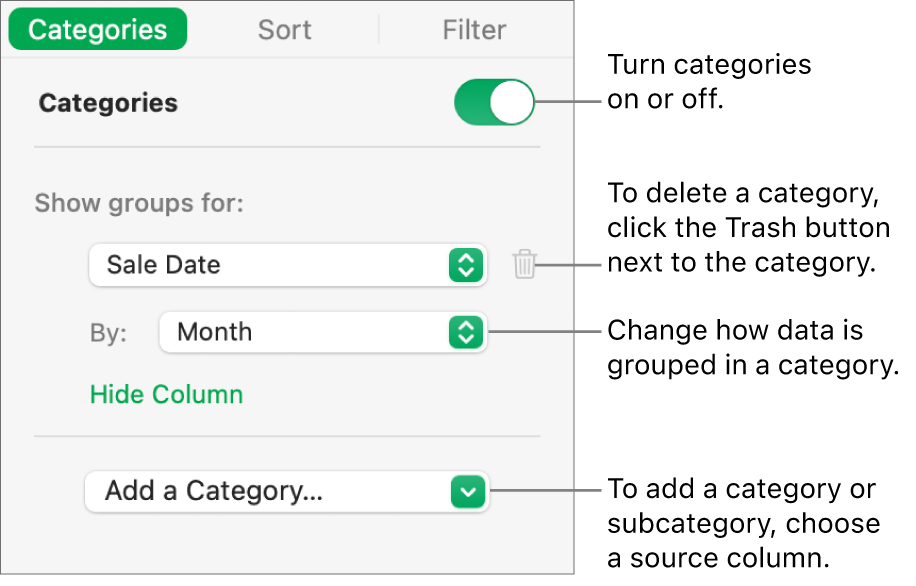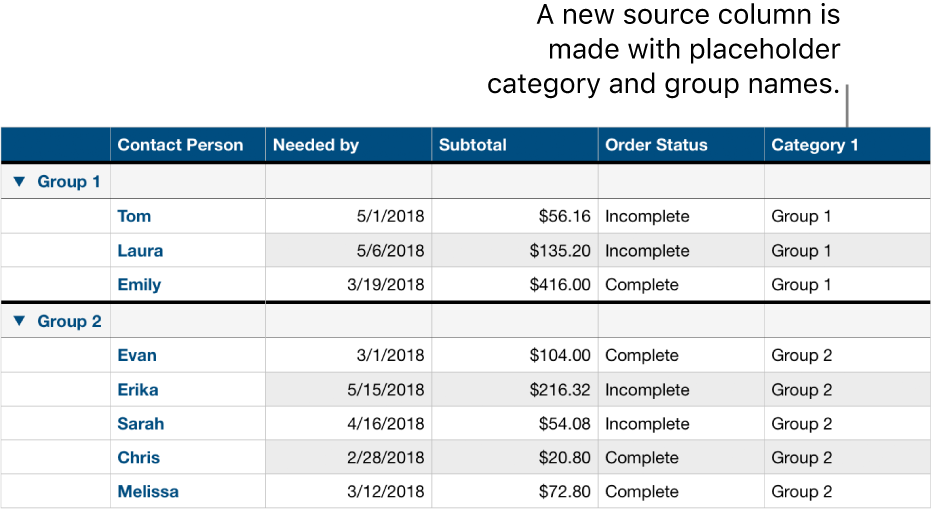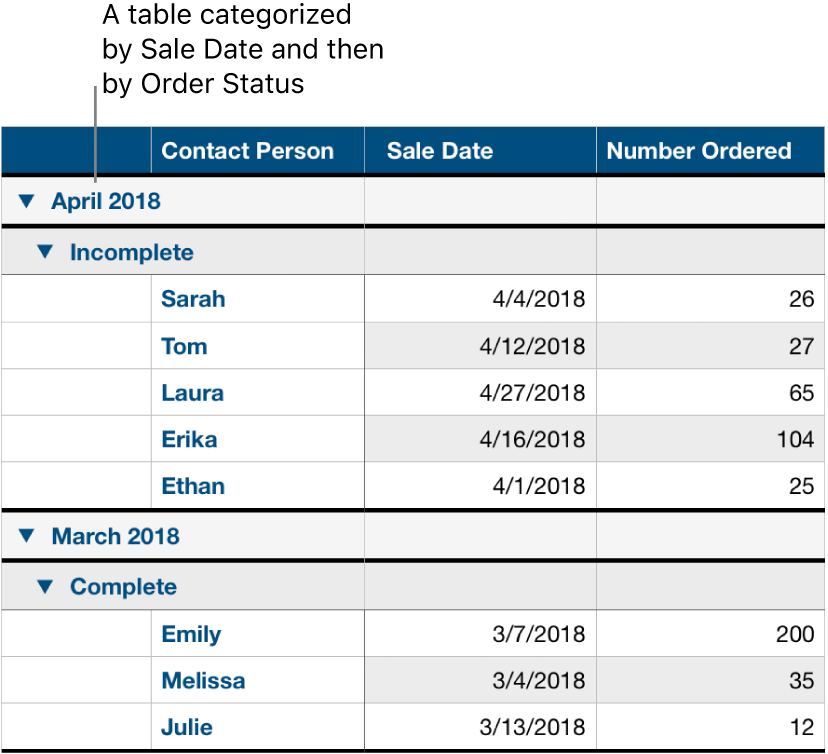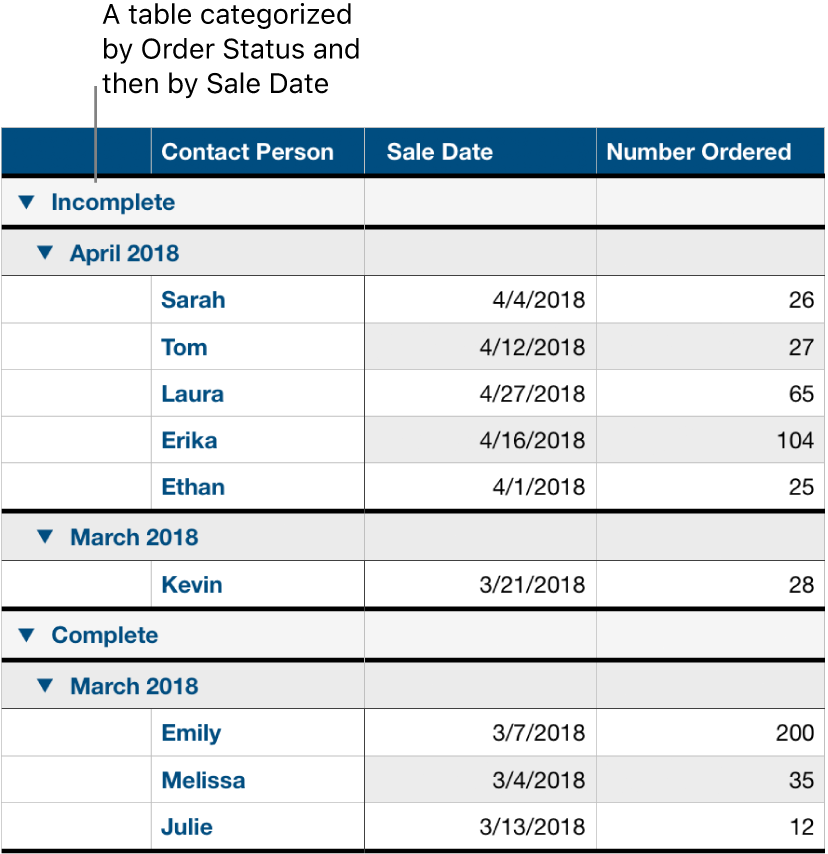
Add, edit, or delete categories in Numbers on Mac
You can use categories to organize the data in your table. For example, if you have a spreadsheet that tracks shirt sales, you could create a category that groups sales by month or by salesperson.
There are two ways to create a category in Numbers: choose a source column of data that you want to group, or manually select rows that you want to group. Choosing a source column is best when your table already contains the data you want to group. Manually selecting rows works best when the data you want to group isn’t in the table. For example, you might have a table that’s a roster of students in your class. If the students created their own groups for a science project, you could organize the roster by these groups without adding a “science project” column to the table.
A table can have one main category and up to four subcategories to create a hierarchy for your data. You can change this hierarchy, rename or delete categories, and more.

Create a category from a source column
If the data you want to use for a category is already in your table, you can select the column that contains the data (the source column), and Numbers automatically creates groups based on shared values in the column.
In the toolbar, click
 , then choose the column you want to use to create the category.
, then choose the column you want to use to create the category.For example, if your table has data for shirt sales, you might choose the Sales Date column so you can see sales grouped by month.
To add a subcategory, click
 , then select a different column.
, then select a different column.For example, in the shirt sales table, you could add a subcategory based on salesperson, to view sales by month and by salesperson.
Create a category from a selection of rows
If there is no source column of data for the category you want to add, you can manually create categories by selecting rows you want to group. For example, for a table that lists colleges you’re interested in, with columns for state, tuition, and distance, you might want to organize it by colleges you want to visit. You could simply select the row for each college to manually create a category, so you wouldn’t need to add a column for it to the table.
You can also select rows in an already categorized table to create additional groups.
Select the rows you want to group together in your table.
Move the pointer over a row number in your selection, then choose Create Group for Selected Rows.
If there are no other categories in the table, a source column called Category 1 is added to the end of the table.
Two groups are added to the table, labeled Group 1 and Group 2; one for the data you selected, and one for the data you didn’t select.
If the table is already categorized, the new group is given a placeholder name in the existing source column (instead of creating a new category).

Change the hierarchy of the categories
If your table contains subcategories, you can move a category up or down one or more levels to reorganize your data. For example, if you have a table that categorizes shirt sales by sale date and then by order status, you could reorganize to categorize by order status first and then by sale date.
Select the table.
In the Organize
 sidebar, click Categories.
sidebar, click Categories.Drag
 up or down next to the category you want to move.
up or down next to the category you want to move.

Hide or show a category source column
You can hide a category source column to reduce the amount of data shown in a categorized table. The table remains categorized by the data from the hidden column.
In the Organize
 sidebar, click Categories.
sidebar, click Categories.Below the pop-up menu with the name of the source column, click Hide Column or Unhide Column.
If you turn off categories while a column is hidden, it remains hidden. See Hide or show rows and columns.
Rename a category
Click the source column cell that contains the category name you want to change.
Note: The summary row label containing the category name can’t be edited.
Type a new name, then press Return.
Turn categories on or off
To go back to seeing your data uncategorized, you can turn categories off. You can turn them back on to see the data categorized again at any time, and your data is regrouped based on any edits you made while categories were turned off.
In the Organize
 sidebar, click Categories, then turn Categories on or off.
sidebar, click Categories, then turn Categories on or off.
Delete a category
You can delete a category so your table is no longer grouped by its data (the data itself remains in the table). When you delete a category that has subcategories, the subcategories move up in the hierarchy.
In the Organize
 sidebar, click Categories, then click
sidebar, click Categories, then click  next to the category you want to delete.
next to the category you want to delete.
